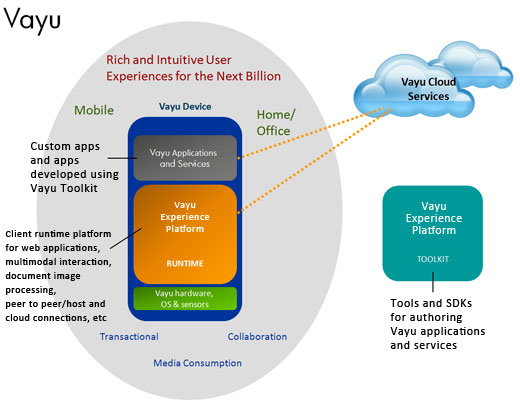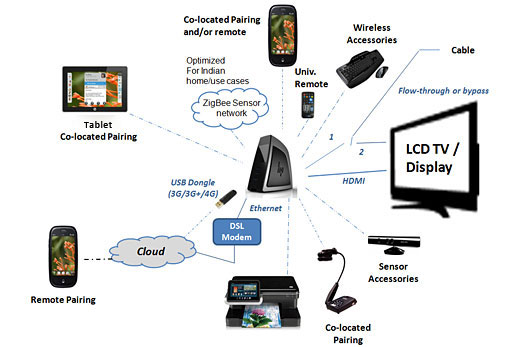HP Labs India
| Vayu |
| Overview |
The Vayu project at HP Labs India, aims to deliver the value of computing and the internet for first time users in countries like India where IT penetration is still very low. Studies have shown that the reason for low PC usage is not just due to cost of computers. There is a significant fraction of the population, with a reasonable purchasing power - characterized in India by the 200M families and small businesses in small towns - that do not invest in computing or internet access. This is because of the lack of a perceived value proposition (unlike a TV or a mobile phone), the complexity of the interaction (keyboard, mouse, complex desktop interfaces), lack of relevant local language content and deeply entrenched paper-based processes in their lifestyle. The vision of the Vayu project is to address the needs of this population. This is done by leveraging the high ownership and familiarity with mobile phones, TV and paper to deliver rich and intuitive user experiences with compelling value propositions for everyone in the family at an affordable cost.
The project converges the use of a TV, mobile phones and paper and enables rich Internet experience in living room at a home as well as for small businesses without the user owning or operating a complex computer. Researchers at HP Labs India have created an end-to-end solution - termed Vayu - which delivers novel application experiences (Vayu User Experiences) developed on a distributed software platform called the Vayu Experience Platform (VEP) and deployed on a new protoype hardware device (called VInD) which is connected to a television. Given the proliferation of cell phone users in India and similar geographies and their familiarity with television (TV) and paper for content consumption, the project's vision is to migrate cell phone users towards computing experiences in an evolutionary and step-wise manner. This is done by delivering a user internet experience without engaging with a keyboard and mouse, but through intelligent user interfaces utilizing gestures, speech, paper and other interaction paradigms such as web tasks and web channels.
| Motivation |
This project is based on some basic assumptions that have been validated in the Indian marketplace namely,
- The number of mobile users will continue to be greater than the number of PC users by an order of magnitude in the foreseeable future.
- It is easier for an average user to migrate from the mobile handset to the PC experience in an evolutionary and step-wise manner.
Furthermore, the uptake of the PCs in the emerging markets has been quite slow due to many
barriers, notable among them being:
- Lack of clear value proposition for desktops, laptops etc.
- Complexity of interaction (e.g. use of a keyboard for a non-English speaker)
| The Vayu Project |
Vayu converges user experiences through simplified user interactions. To reduce the complexity of interaction, Vayu enables the use of interaction models most users are already familiar with - From a platform perspective, this meant enabling the use of an off-the-shelf infra-red(IR) remote control and speech and gesture inputs which are more intuitive than the keyboard (more so for non-English speakers). From an interaction design perspective, this meant the enabling of web consumption via paradigms like “channels” and “widgets” - which can be easily authored and customized. Additionally, to leverage the widespread penetration of mobile phones, Vayu supports a unique feature of "pairing" multiple mobile phones to Vayu so as to allow family members with mobile phones to interact with Vayu from their mobiles - no matter which type of phone they use or where they are located.
The above requirements needed in an end-to-end solution where HP researchers have designed the complete computing stack - the hardware, platform software and the user experience - to deliver intuitive, rich and simplified computing experiences. Hence, the solution comprises of three important components:
- A set of validated rich and intuitive Vayu User Experiences (VUE)
- A distributed software platform - Vayu Experience Platform (VEP) that includes unique and novel technology components such as natural multimodal human-computer interaction, paper based interaction, and simplified web interaction.
- A suitable Hardware - VInD prototype that can be connected to a TV, work with mobile phones and enable additional accessories for rich experiences.
Figure 1 below depicts these components deployed both on the client and cloud. For more information, visit Resources.
 |
| Fig 1: Vayu Overview |
| Vayu User Experiences (VUE) |
Vayu User Experiences are a set of use case scenarios that demonstrate how the proposed solution comprised of the Vayu Internet Device (VInD), applications and service ecosystem can satisfy the real entertainment, productivity, education and communication needs of the majority of teh users , while at home, at work, or on the move.
Further, these use cases demonstrate different uses of the mobile device and VInD when separated and paired. The use cases we have developed also attempt to marry these value propositions with appropriate interaction options that include simple TV remote based interactions, using a smart-phone as a TV remote, multimodal gestures, paper-based interfaces, packaged task-based web interactions, and personalized delivery of media and information.
| more >> |
| Vayu Experience Platform (VEP) - Software |
All the Vayu User Experiences are developed and deployed over the software platform called Vayu Experience Platform. It supports technologies for recognizing inputs from a remote control, novel rich interaction technologies such as gestures, speech, touch and so on. It also implements new protocols for support paired devices and secure communication between them.
Another aspect of the Vayu Experience Platform is its authoring support. It can be seen that while novel interaction technologies are emerging, today there are only a limited number of applications that take advantage of such rich interactions. This is mainly because, such applications can only be developed by technical experts who know how to play with the intricate configuration and other aspects of the API/drivers for such sensors. Vayu Experience Platform also aims to break this barrier and support easy and dynamic creation of user experiences. The software platform enables users to dynamically and declaratively specify user interactions by decoupling the complexities of various interaction technologies from the application developer. Further, the service-oriented nature of the platform helps in easily moving various components either to client or to the cloud based on the needs.
| more >> |
| Vayu Internet Device (VInD) |
The VInD is a stationary platform designed for living room computing. It has interfaces to connect it to external displays,a TV, a keyboard, a sensor bar, cameras, a printer,a scanner and other peripheral devices. It is left to the user to decide what external devices he or she wants to connect with VInD depending on his or her level of comfort with the chosen device and ability to afford. The VInD is an innovative hardware platform (beta) which has the flexibility to grow from a basic very low-cost configuration to a high-end multimedia configuration so that the user can realize a greater set of rich user experiences.
The Vayu hardware eco system with VInD connected to TV and various peripherals is depicted in the diagram below (Figure 2). |
| Fig 2: Vayu Hardware Eco system |
| more >> |
This page was last updated on February 1, 2012